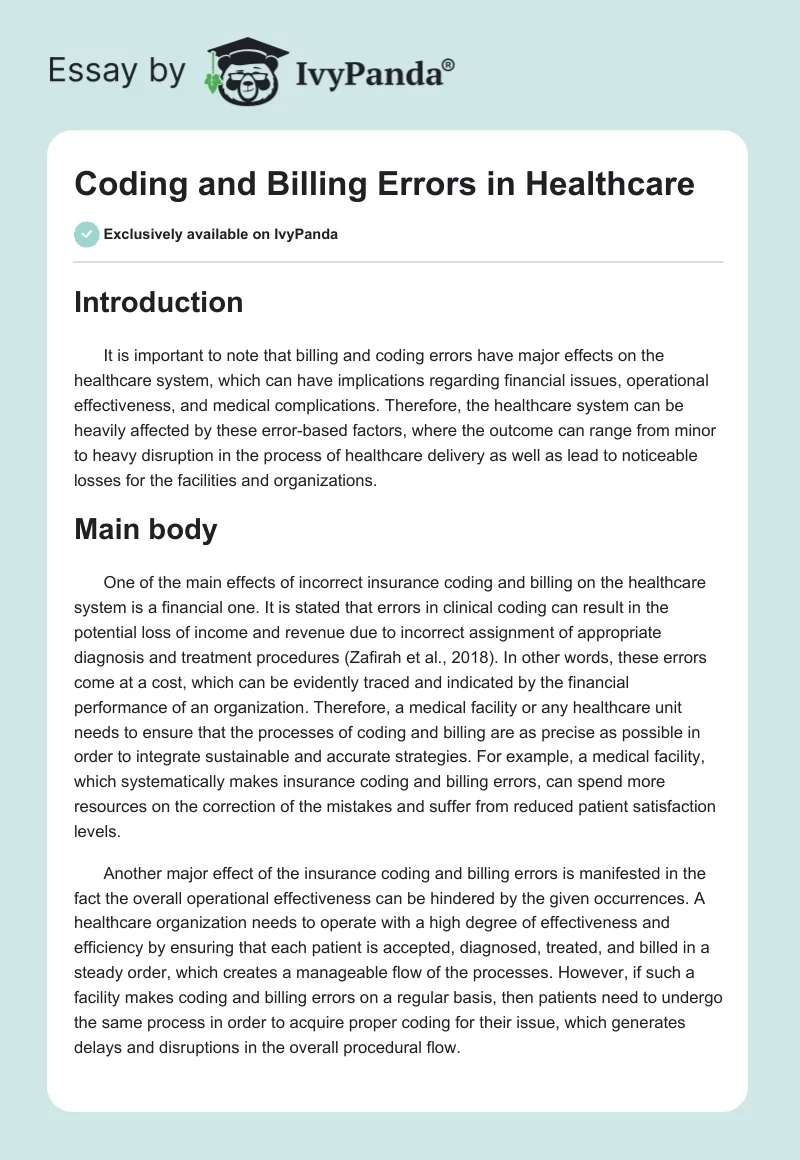Introduction
It is important to note that billing and coding errors have major effects on the healthcare system, which can have implications regarding financial issues, operational effectiveness, and medical complications. Therefore, the healthcare system can be heavily affected by these error-based factors, where the outcome can range from minor to heavy disruption in the process of healthcare delivery as well as lead to noticeable losses for the facilities and organizations.
Main body
One of the main effects of incorrect insurance coding and billing on the healthcare system is a financial one. It is stated that errors in clinical coding can result in the potential loss of income and revenue due to incorrect assignment of appropriate diagnosis and treatment procedures (Zafirah et al., 2018). In other words, these errors come at a cost, which can be evidently traced and indicated by the financial performance of an organization. Therefore, a medical facility or any healthcare unit needs to ensure that the processes of coding and billing are as precise as possible in order to integrate sustainable and accurate strategies. For example, a medical facility, which systematically makes insurance coding and billing errors, can spend more resources on the correction of the mistakes and suffer from reduced patient satisfaction levels.
Another major effect of the insurance coding and billing errors is manifested in the fact the overall operational effectiveness can be hindered by the given occurrences. A healthcare organization needs to operate with a high degree of effectiveness and efficiency by ensuring that each patient is accepted, diagnosed, treated, and billed in a steady order, which creates a manageable flow of the processes. However, if such a facility makes coding and billing errors on a regular basis, then patients need to undergo the same process in order to acquire proper coding for their issue, which generates delays and disruptions in the overall procedural flow.
It should also be noted that one of the most important and damaging effects of insurance coding and billing error is rooted in the fact that it leads to medical complications. It is stated that insurance coding might “overestimate the actual effect of obesity on complications after arthroplasty” (George et al., 2017, p. 86). In other words, errors in coding can lead to either underestimation or overestimation of a health issue, where the latter can result in an excessive burden on the healthcare system. In addition, the former form of error can lead to an inappropriate diagnosis of a patient, where his or her disease is not treated in a sufficient manner. These incidents might become a reason for patients developing avoidable complications, which require more extensive resources and procedures.
Therefore, a healthcare unit or facility needs to ensure that coding and billing errors do not take place, especially systematically, because the healthcare system will inevitably become ineffective at treating preventable illnesses and will constantly need to work on more challenging cases. In addition, such errors can also result in an increase in death rates due to a delayed diagnosis and treatment since correcting these mistakes requires an additional time and waiting period for reassessment.
Conclusion
In conclusion, the effects of incorrect insurance coding and billing on the healthcare system are manifested in three areas which are financial issues, operational effectiveness, and medical complications. A healthcare organization will inevitably suffer from revenue and income losses due to these coding and billing errors. The operational flow of patients can also be disrupted by the fact that some patients will need to undergo the procedures repeatedly. In addition, these errors can result in inappropriate diagnosis and treatment, which can lead to health complications and even death due to delays.
References
George, J., Newman, J. M., Ramanathan, D., Klika, A. K., Higuera, C. A., & Barsoum, W. K. (2017). Administrative databases can yield false conclusions—An example of obesity in total joint arthroplasty. The Journal of Arthroplasty, 32(9), 86–90. Web.
Zafirah, S. A., Nur, A. M., Puteh, S. E. W., & Aljunid, S. M. (2018). Potential loss of revenue due to errors in clinical coding during the implementation of the Malaysia diagnosis related group (MY-DRG®) Casemix system in a teaching hospital in Malaysia. BMC Health Services Research, 18(1), 1-11. Web.


